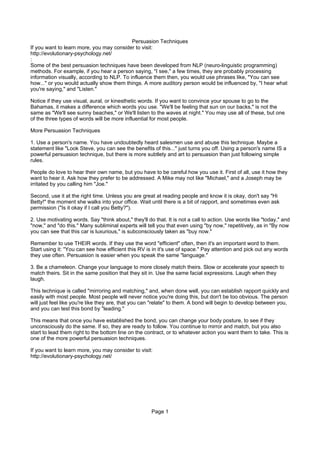Persuasion Techniques
- 1. Persuasion Techniques If you want to learn more, you may consider to visit: http://evolutionary-psychology.net/ : Some of the best persuasion techniques have been developed from NLP (neuro-linguistic programming) methods. For example, if you hear a person saying, "I see," a few times, they are probably processing information visually, according to NLP. To influence them then, you would use phrases like, "You can see how..." or you would actually show them things. A more auditory person would be influenced by, "I hear what you're saying," and "Listen." Notice if they use visual, aural, or kinesthetic words. If you want to convince your spouse to go to the Bahamas, it makes a difference which words you use. "We'll be feeling that sun on our backs," is not the same as "We'll see sunny beaches," or We'll listen to the waves at night." You may use all of these, but one of the three types of words will be more influential for most people. More Persuasion Techniques 1. Use a person's name. You have undoubtedly heard salesmen use and abuse this technique. Maybe a statement like "Look Steve, you can see the benefits of this..." just turns you off. Using a person's name IS a powerful persuasion technique, but there is more subtlety and art to persuasion than just following simple rules. People do love to hear their own name, but you have to be careful how you use it. First of all, use it how they want to hear it. Ask how they prefer to be addressed. A Mike may not like "Michael," and a Joseph may be irritated by you calling him "Joe." Second, use it at the right time. Unless you are great at reading people and know it is okay, don't say "Hi Betty!" the moment she walks into your office. Wait until there is a bit of rapport, and sometimes even ask permission ("Is it okay if I call you Betty?"). 2. Use motivating words. Say "think about," they'll do that. It is not a call to action. Use words like "today," and "now," and "do this." Many subliminal experts will tell you that even using "by now," repetitively, as in "By now you can see that this car is luxurious," is subconsciously taken as "buy now." Remember to use THEIR words. If they use the word "efficient" often, then it's an important word to them. Start using it: "You can see how efficient this RV is in it's use of space." Pay attention and pick out any words they use often. Persuasion is easier when you speak the same "language." 3. Be a chameleon. Change your language to more closely match theirs. Slow or accelerate your speech to match theirs. Sit in the same position that they sit in. Use the same facial expressions. Laugh when they laugh. This technique is called "mirroring and matching," and, when done well, you can establish rapport quickly and easily with most people. Most people will never notice you're doing this, but don't be too obvious. The person will just feel like you're like they are, that you can "relate" to them. A bond will begin to develop between you, and you can test this bond by "leading." This means that once you have established the bond, you can change your body posture, to see if they unconsciously do the same. If so, they are ready to follow. You continue to mirror and match, but you also start to lead them right to the bottom line on the contract, or to whatever action you want them to take. This is one of the more powerful persuasion techniques. If you want to learn more, you may consider to visit: http://evolutionary-psychology.net/ Page 1

